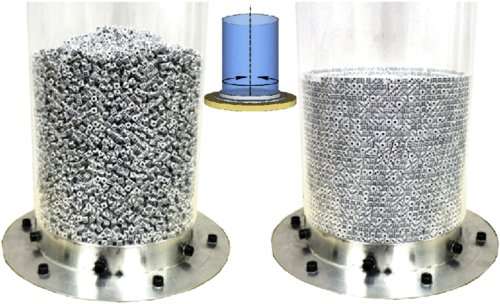December 7, 2017 report
Applying alternating twists to cylindrical container found to cause dice to line up

(Phys.org)—A small team of researchers from Universidad de Navarrahas in Spain and Cinvestav Unidad Monterrey in Mexico has found that applying alternating twists to a cylinder full of square dice causes the dice to line up. In their paper published in the journal Physical Review Letters, the group describes their experiments with agitating dice and what they found.
Most people have witnessed what happens when randomly agitating a jar full of rocks, nuts or other hard objects—over a short time, they line up in a way that causes them to become more compacted. Manufacturers have learned to take advantage of this by designing machines that agitate or tap containers to compress the materials. In this new effort, the researchers report that alternating agitation does an even better job, at least with small, square objects.
In their experiments, the researchers loaded 25,000 plastic dice, each approximately a half-centimeter on a side, into a clear cylinder. They then applied different agitation effects to the cylinder to see which might cause the most effective compaction. They found that an alternating twisting, similar to that used by a common clothes washing machines worked best—but only when enough acceleration was applied. They found that the applied rotation exerted an outward force against the walls of the cylinder while the jolt that occurred when a spin motion was suddenly halted and then reversed caused the dice to shuffle slightly. Applying the alternating twisting technique caused the dice to line up top to bottom and also to form concentric circles when looked at from above.
The researchers also found that for the technique to work, enough rotational acceleration had to be applied to sufficiently cause a useful amount of movement by the dice when it was suddenly halted. More specifically, they found that acceleration of approximately half that of gravity caused the dice to reach a maximum density after 10,000 alternating twists. Lower accelerations were not sufficient to cause the dice to line up in a reasonable amount of time.
The researchers suggest their findings offer a possible new means of compacting materials as part of a manufacturing processes.
More information: K. Asencio et al. Experimental Study of Ordering of Hard Cubes by Shearing, Physical Review Letters (2017). DOI: 10.1103/PhysRevLett.119.228002
ABSTRACT
We experimentally analyze the compaction dynamics of an ensemble of cubic particles submitted to a novel type of excitation. Instead of the standard tapping procedure used in granular materials we apply alternative twists to the cylindrical container. Under this agitation, the development of shear forces among the different layers of cubes leads to particle alignment. As a result, the packing fraction grows monotonically with the number of twists. If the intensity of the excitations is sufficiently large, an ordered final state is reached where the volume fraction is the densest possible compatible with the boundary condition. This ordered final state resembles the tetratic or cubatic phases observed in colloids.
Journal information: Physical Review Letters
© 2017 Phys.org

















